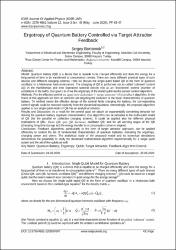| dc.contributor.author | Sergey Borisenok | |
| dc.date.accessioned | 2021-06-22T11:53:55Z | |
| dc.date.available | 2021-06-22T11:53:55Z | |
| dc.date.issued | 2020 | en_US |
| dc.identifier.issn | 2278-4861 | |
| dc.identifier.uri | https://hdl.handle.net/20.500.12573/847 | |
| dc.description.abstract | Model: Quantum battery (QB) is a device that is capable to be charged efficiently and store the energy for a
long period of time to be transferred to consumption centers. There are many different physical types of such
devices and different charging schemes. Here we discuss the single-qubit based QB in the form of quantum
oscillator in a Markovian bath environment. The charging of QB is performed via so-called 'coherent' control
u(t) in the Hamiltonian and time dependent spectral density n(t) as an 'incoherent' control (number of
excitations in the bath). Our goal is to drive the ergotropy of the stored qubit via the certain control algorithm.
Methods: For the effective control we apply here Kolesnikov’s ‘target attractor’ (TA) feedback algorithm. In the
frame of this approach we form an attractor set targeting the evolution of the basic characteristics of quantum
battery. TA method makes the effective design of the control fields charging the battery; the corresponding
control signals could be restored explicitly from the dynamical equations. Interestingly, the proposed algorithm
applied to our single qubit model of QB has an analytical solution.
Results and Discussion: As a result for the control goal, we obtain an exponentially converting behavior for
driving the quantum battery ergotopic characteristics. Our algorithm can be extended to the multi-qubit model
of QB (for the parallel or collective charging scheme). It could be applied also for different physical
realizations of QBs: Dicke QB, spin QB, harmoniс oscillator QB; and for all working stages of the QB
(charging, long time storage and the energy transfer to a consumption center or engine).
Conclusion: Feedback algorithms, particularly in the form of target attractor approach, can be applied
efficiently to control the set of fundamental characteristics of quantum batteries, including the ergotropy,
charging power and others. The analytical study of the proposed model and its numerical simulations
demonstrate the possibility to imply the developed mathematical algorithm experimentally for a single qubit
system and the set of few qubits as well. | en_US |
| dc.language.iso | eng | en_US |
| dc.publisher | IOSR Journal Of Applied Physics (IOSR-JAP) | en_US |
| dc.rights | info:eu-repo/semantics/openAccess | en_US |
| dc.subject | Feedback Algorithm Control | en_US |
| dc.subject | Target Attractor | en_US |
| dc.subject | Qubit | en_US |
| dc.subject | Ergotropy | en_US |
| dc.subject | Quantum Battery | en_US |
| dc.title | Ergotropy of Quantum Battery Controlled via Target Attractor Feedback | en_US |
| dc.type | article | en_US |
| dc.contributor.department | AGÜ, Mühendislik Fakültesi, Elektrik - Elektronik Mühendisliği Bölümü | en_US |
| dc.identifier.volume | Volume 12, Issue 3 | en_US |
| dc.identifier.startpage | 43 | en_US |
| dc.identifier.endpage | 47 | en_US |
| dc.relation.journal | IOSR Journal Of Applied Physics (IOSR-JAP) | en_US |
| dc.relation.publicationcategory | Makale - Uluslararası - Editör Denetimli Dergi | en_US |


















